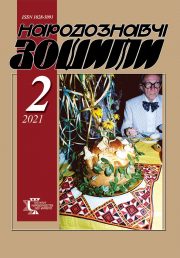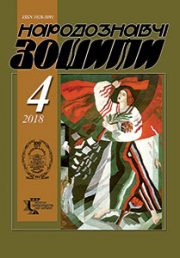The Ethnology Notebooks. 2019, № 3 (147), 684—697
UDK 398.1(=161.3):316.6:291.33:133.4:811.161.3
DOI https://doi.org/10.15407/nz2019.03.684
KANAPLIANIKAU Dzmitry
ORCID ID: https://orcid.org/0000-0002-4957-1619
PhD Candidate at the
Department of the modern ethnology of the Institute of Ethnology of the
National Academy of Sciences of Ukraine
Svobody Avenue 15, 79000, Lviv, Ukraine.
Contacts: e-mail: zvyczaj@gmail.com
Tacjana TOUSCIK
ORCID ID: https://orcid.org/0000-0001-7462-5060
Homel society of local history«Talaka»
Liaљиynskaja, 26, 1, 246008, Homel, Belarus
Contacts: e-mail: tolscik@gmail.com
Abstract. We studied traditional Belarusian representation of such substances as blood, spirit, soul, power, knowledge, charms, evil eye. Many older Belarusians who live in the villages, believe that these substances have supernatural properties and were found in humans, animals, supernatural beings, things. People, other creatures, can transmit these substances, with the result that the state of the human body can be a healthy patient, that acquired supernatural properties.
We have studied the representations of substance and traditional medicine as a complex system based on the combination of methods of the theory of systems and cognitive sciences. We conducted fieldwork in Belarusian villages, interviewed informants about the substances of organisms, including metaphysical supernatural concepts, as well as medical ritual texts.
People who have supernatural properties of the substances of the body, play the social role of specialists having special knowledge — a wizard, witches, sorcerers, healer. Social relationships that arise as a result of these beliefs, have the character of rituals that aim to harm or treatment. Thus formed social system in which there are data exchanges information about the state of organisms and their procedures change states through rituals. Data management is done through the submission of the substance that forms the negative and positive feedback — respectively, aimed at improving or deteriorating conditions of the body, or the formation of new organisms. In accordance with the ideas of people that make decisions about social connections and actions, they have a ritual character.
Coordination in the control aspect is carried out at the level of individuals and experts through exchanges of data on the state of organisms and substances, with the formation of positive and negative feedback between people, experts in sacred knowledge, supernatural beings, natural units. The purpose of this system is the body’s deterioration or improvement of conditions or the formation of new organisms.
Keywords: Personhood, Person, European mythology, European paganism, soul, blood, spirit, power, sacred knowledge, traditional knowledge, charms, evil eye, social system, feedback.
Received 8.04.2019
REFERENCES
Balagutrak, M. (2018). Ethnopsychological views of Mikhail Drahomanov and Ivan Franko and a new era of European humanism. The Ethnology Nоtebooks, 1 (139), 80—90 [in Ukrainian].
Balagutrak, M. (2007). Genesis of ethnopsychology in Ukraine of the XIX century: historical and ethnological aspect. Lviv: The Ethnology Institute of National Academy of Sciences of Ukraine [in Ukrainian].
Potebnya, A.A. (1999). Complete Works: Thought and Language. Moscow: Labyrinth [in Russian].
Durkheim, Й. (1893). From the division of social work. (Doctoral dissertation). Faculty of Arts of Paris [in French].
Durkheim, E., & Mauss, M. (1903). On Some Primitive Forms of Classification: Contribution to the Study of Collective Representations. L’Annйe Sociologique, 6, 1—72. [in French].
Moscovici, S. (2001). Social Representations: Essays in Social Psychology. New York: NYU Press.
D’Andrade, R.G. (1995). The development of cognitive anthropology. Cambridge: Cambridge University Press.
Bernard, H.R. (2006). Research methods in anthropology: qualitative and quantitative approaches (4th ed.). Lanham; New York; Toronto; Oxford: AltaMira Press.
Burke, P. (2004). What is cultural history? Cambridge, U.K.; Malden, MA: Polity Press.
Sammut, G., Andreouli, E., Gaskell, G., & Valsiner, J. (2015). The Cambridge handbook of social representations. Cambridge: Cambridge University Press.
Sammut, G. (2015). Attitudes, social representations and points of view. In The Cambridge Handbook of Social Representations (pp. 96—112). Cambridge UK: Cambridge University Press.
Hippocrates, & Jacques, J. (2002). On the Nature of Man. Berlin: Akademie Verlag [in Ancient Greek, French].
Hippocrates. (1927). On Breaths. In Hippocratis Indexes books (pp. 91—101). Leipzig: Teubner [in Ancient Greek].
Schneider, D.M. (1980). American kinship: a cultural account. Chicago: University of Chicago Press.
Carsten, J. (2004). After Kinship. Cambridge; New York; Melbourne; Madrid; Cape Town; Singapore; Sгo Paulo: Cambridge University Press.
Wiener, N. (1965). Cybernetics or the control and communication in the animal and the machine. Cambridge: M.I.T. Press.
Mesarović, M.D., Macko, D., Takahara, Y., & Bürger, G.A. (1970). Theory of Hierarchical, Multilevel, Systems. Human & Rousseau.
Tzafestas, S.G. (2018). Energy, Information, Feedback, Adaptation, and Self-organization. Cham: Springer International Publishing. DOI: https://doi.org/10.1007/978-3-319-66999-1.
Doіęga-Chodakowski, Z. (1967). On Slavicness before Christianity: and other letters and letters. Warszawa: Polish Scientific Publishers [in Polish].
Boltarovich, Z.Ye. (1990). Folk medicine of Ukrainians. Kiev: Naukova Dumka [in Ukrainian].
Valodzina, T.V. (2007). Traditional medicine ritual and magical practices. Minsk: Belarusian science [in Belarusian].
Valodzina, T.V. (2009). The human body: the word, myth, ritual. Minsk: Technology [in Belarusian].
Touscik, T.C. (2008). The concept of the soul in the lower Christian culture of Belarusians. In Christianity in the historical fate of the Belarusian people: collection of scientific articles (pp. 265—268). Grodna: Yanka Kupala State University of Grodna [in Belarusian].
Touscik, T. (2007). Body and soul in the Belarusian folk tradition. Retrieved from http://traditionalworldview.blogspot.com/2013/04/touscik-tacjana-ciao-i-dusza-w.html [in Polish].
Hanиar, U. (2007). The hospital as a place of activity of healers from the Belarusians from the Eastern Palessie and Dneper River Basin. In Romanov read 4: Proceedings of the International scientific conference (pp. 107—108). Mahilioŭ: Mahilioŭ State A. Kuleshov University [in Belarusian].
Hanиar, U. (2011). Types «those who know» in Belarusian Palessie and their changes in the twentieth century — the beginning of XXI century. Vesnik of Palessky State University. Series of social and humanitarian Sciences, 1, 20—26 [in Belarusian].
Lobaи, U.A. (2014). The image of the wizard in the traditional picture of Belarusians of the World Move over XX — beg. XXI century (according to data from ethnographic expeditions). In D.U. DuK, V.A. Jemialjanиyk, A.I. Korsak, & U.A. Lobaи (Eds.). Belarusian from the Dzvina River Basin: experience, methodology and results of the fieldwork and interdisciplinary research: Proceeding of the II International Scientific Conference (Polack, 17—18 April 2014): the 20th anniversary of archaeological and ethnographic expeditions of PSU (pp. 213—219). Novapolack: Polack State University [in Belarusian].
Lobaи, U.A., & Filipienka, U.S. (2006a). Traditional medicine Belarusian of Dzvina River Basin. Pоlack ethnographic collection (Issue 1, part 1). Novapolack: PSU [in Belarusian].
Lobaи, U.A., & Filipienka, U.S. (2006b). Traditional medicine Belarusian of Dzvina River Basin Pоlack ethnographic collection (Issue 1. part 2). Novapolack: PSU [in Belarusian].
Vinogradova, L.N., & Levkievskaya, E.E. (2012). Demonologization of deceased people. In Folk demonology of Polesie: Publications of texts in the records of the 80s — 90s of the 20th century (Vol. 2). Moscow: Languages of Slavic cultures [in Ukrainian, Belarusian, Rusian].
Vinogradova, L.N., & Levkievskaya, E.E. (2010). People with supernatural properties. In Folk demonology of Polesie: Publications of texts in the records of the 80s — 90s of the 20th century (Vol. 1). Moscow: Languages of Slavic cultures [in Ukrainian, Belarusian, Rusian].
Agapkina, T.A., Levkievskaya, E.E., & Toporkov, A.L. (2003). Polesian Verbal Charms (in the records of 1970—1990). Moscow: Indrik [in Ukrainian, Belarusian, Rusian].
Kolodyuk, I.V. (2006). Folk medicine in the traditional Ukrainian culture of the central Polissya (last quarter of the XX — beginning of the XXI century). Kiev: Kyiv University [in Ukrainian].
Ignatenko, I.V. (2016). Folk medicine and magic of Ukrainians: beliefs, mythology, worldview, secrets of folk medicine, superstitions. Kharkiv: Book Club «Family Leisure Club» [in Ukrainian].
Glushko, M. (2015). Folk medicine Volynians (from records in Dubrovka village of Baranivsky district of Zhytomyr region).Visnyk of the Lviv University. Series History, 51, 549—580 [in Ukrainian].
Kanaplianikau, D.H.(2018). Etnagraficzny_Archiu_Kanaplianikau_Zmitro. Retrieved March 18, 2019 from https://drive.google.com/drive/folders/1n8qPHeRbiryCNuaO–n0IO579lSNDC-r?usp=sharing [in Belarusian].
Archive Homel society of local history «Talaka». Book № 1/1995 «Petrykaŭ — 1995» [in Belarusian].
Bondarchik, V.K, Kabashnikav, K.P, Fedosik, A.S., & Bartashevich, H.A. (1992). Verbal Charms. Minsk: Science and Technology [in Belarusian].
Gunchik, I. (2008). Western Polissya Verbal Charms and Folk prayers from blood. Mythology and Folklore, 1—2 (16), 137—150 [in Ukrainian].
Boganeva, A.M, Valodzina, T.V., Kozenka, M.A, Lobaevskaya, V.A, & Smirnova, I.Ju. (2013). Gomel Palessie and Dnieper River Basin. In Traditional art culture of the Belarusians (Vol. 1, book 2). Minsk: Higher School [in Belarusian].
Lobaи, U.A. (2011). Traditional medicine Belarusian from the Dzvina River Basin. In Pоlack ethnographic collection (Issue 2, part 2). Novapolack: PSU [in Belarusian].
Lugo, L., Cooperman, A., Stencel, S., Smith, G., Pond, A., Sahgal, N., Poushter, J. (2009). Many Americans Mix Multiple Faiths. Eastern, New Age Beliefs Widespread. Retrieved June 28, 2018 from: http://www.pewforum.org/2009/12/09/many-americans-mix-multiple-faiths/#ghosts-fortunetellers-and-communicating-with-the-dead.







